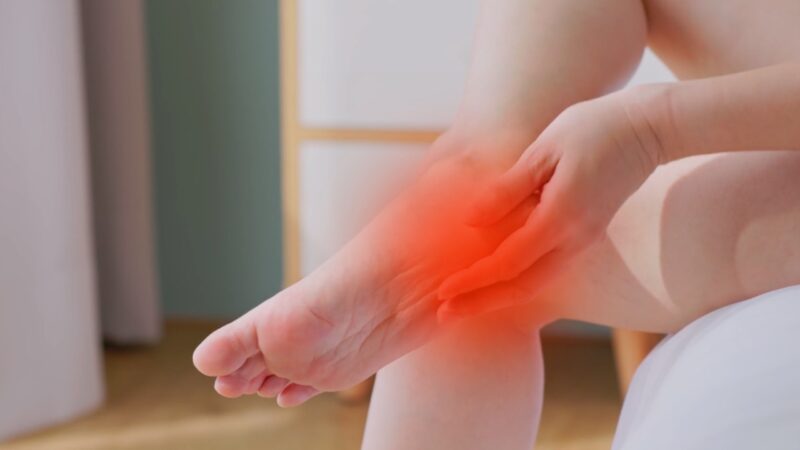Waking up to the discomfort of heel pain can disrupt your day from the start. Often, this pain is due to plantar fasciitis, a common condition affecting the foot’s arch and heel.
Fortunately, with the right approach, you can manage and alleviate this pain from the comfort of your home.
In this guide, I’ll will walk you through effective strategies to treat morning heel pain, ensuring your first steps are pain-free and your days start on the right foot.
Key Takeaways
- Immediate relief techniques include cold therapy and massage, which help reduce inflammation and alleviate pain by increasing blood flow and stretching the plantar fascia.
- Stretching and strengthening exercises, such as calf stretches, plantar fascia stretches, towel curls, and marble pickups, are crucial for alleviating pressure on the plantar fascia and improving foot flexibility and muscle strength.
- Supportive footwear and orthotics play a significant role in distributing foot pressure evenly, correcting structural abnormalities, and preventing further strain on the plantar fascia.
What Causes Morning Heel Pain?
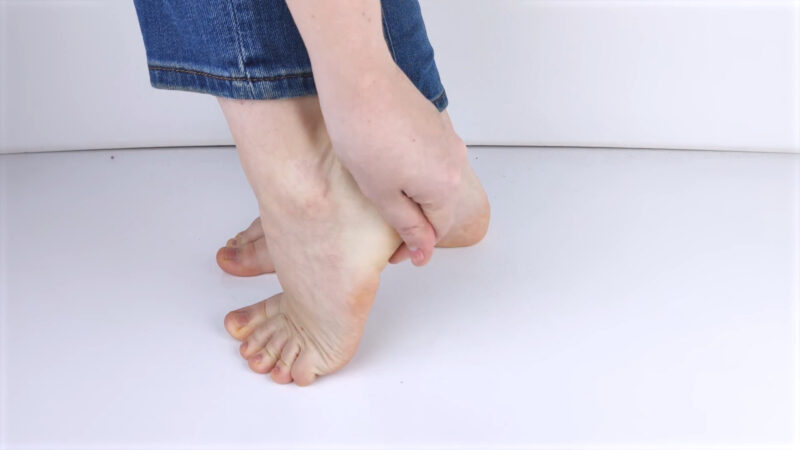
Morning heel pain is commonly caused by plantar fasciitis, a condition characterized by inflammation of the plantar fascia, a thick band of tissue that runs across the bottom of your foot and connects your heel bone to your toes.
This inflammation is often due to overuse, such as from long periods of standing, weight gain, or wearing inadequate footwear, leading to pain and stiffness.
The structure of the foot, such as high arches or flat feet, can also predispose individuals to developing this condition. Engaging in activities that place a lot of stress on the heel and surrounding tissue, like running or ballet, increases the risk.
Additionally, aging can contribute, as wear and tear on the plantar fascia become more likely over time.
The pain is typically worse in the morning because the plantar fascia tightens up overnight. When you take your first steps in the morning, the sudden stretch of the fascia can cause severe pain, which might decrease with movement as the tissue warms up and becomes more flexible.
This phenomenon is known as “post-static dyskinesia” and is a hallmark sign of plantar fasciitis. During the day, micro-tears in the fascia can start to heal, but they might scar and tighten overnight, leading to a cycle of pain and healing.
Symptoms and Diagnosis
- sharp, stabbing pain in the bottom of the foot near the heel,
- stiffness, and discomfort that improves with movement but may worsen after long periods of standing or when you stand up after sitting.
- a dull ache in the heel or arch, along with swelling on the bottom of the foot.
The pain might also flare up after exercise, not necessarily during it, highlighting the stress-induced nature of the condition.
Home Treatment Strategies
Immediate Relief Techniques
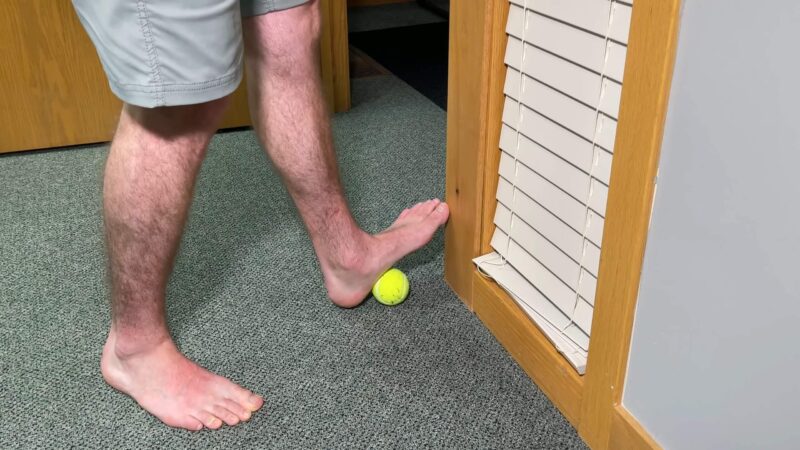
- Cold Therapy: Applying ice to the affected area for 15-20 minutes several times a day can help reduce inflammation and relieve pain. Use a cold pack or a frozen water bottle and roll it under your foot for an easy application. This method also helps numb the painful area, providing temporary relief. Be sure to wrap the ice pack or frozen item in a thin towel to protect your skin from frostbite.
- Massage: Massaging the heel and arch of the foot can help alleviate pain by stretching the plantar fascia and increasing blood flow to the area. Using a tennis ball or a similar object to gently massage the bottom of your foot can be particularly effective. This technique not only helps with pain relief but also promotes flexibility in the plantar fascia and can be a preventative measure against further injuries.
Stretching and Strengthening Exercises
| Exercise Name | Description | Purpose |
| Calf Stretches | Stand an arm’s length from a wall with hands on the wall. Step one foot back while keeping your heel on the ground. Hold for 30 seconds and switch legs. | Alleviates pressure on the plantar fascia by increasing the flexibility of calf muscles, reducing the pull on the heel bone. |
| Plantar Fascia Stretch | Sit and cross one foot over the knee of your other leg. Grasp the toes of your foot and gently pull them towards you until you feel a stretch in the arch of your foot. Hold for 30 seconds and repeat on the other side. | Alleviates tension in the plantar fascia and improves overall flexibility of the foot, making it less prone to injury. |
| Towel Curls | Place a towel on the floor and use your toes to scrunch it towards you. | Enhances the strength of the small muscles in the foot, supports the arch, and can reduce the workload on the plantar fascia. |
| Marble Pickups | Use your toes to pick up marbles and place them in a bowl or similar container. | Improves muscle control and enhances the strength of the small muscles in the foot, supporting the arch and reducing the workload on the plantar fascia. |
Supportive Footwear and Orthotics
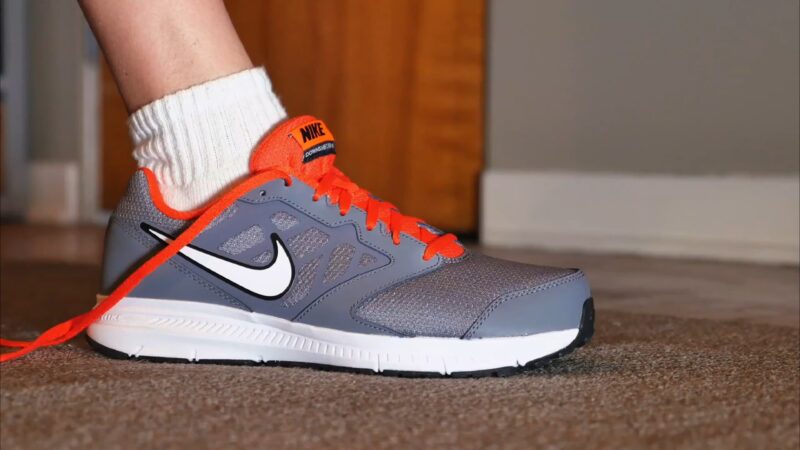
Wear shoes with adequate support, cushioning, and a slight heel. Avoid flat shoes and walking barefoot, especially on hard surfaces. Proper footwear absorbs the impact of walking, reducing stress on the plantar fascia.
Shoes that fit well and provide proper arch support can prevent the condition from developing or worsening. Orthotics can provide additional support and distribute pressure more evenly across your foot.
Both custom and over-the-counter options can be effective, depending on your specific needs. They work by correcting the structural abnormalities of the feet and improving the alignment, which in turn reduces the strain on the plantar fascia.
Lifestyle and Environmental Modifications

Weight Management
Maintaining a healthy weight can reduce the strain on your plantar fascia. Excess body weight puts additional pressure on the feet, particularly on the plantar fascia, which can exacerbate pain and inflammation.
Adopting a balanced diet and regular exercise regimen can help manage weight effectively.
Ergonomic Adjustments
Ensure your work and home environments are set up to support good posture and reduce strain on your feet. Use anti-fatigue mats if you stand for long periods.
These mats provide cushioning, which reduces the amount of stress on the feet and lower limbs, helping to prevent the onset of pain associated with plantar fasciitis.
Night Splints and Socks
Night splints keep your foot in a flexed position overnight, stretching the plantar fascia and calf muscles gently. This consistent stretching can prevent the fascia from tightening and causing pain in the morning.
Night splints are especially useful for individuals who experience significant morning pain.
Compression Socks
These can improve circulation and reduce swelling, potentially easing pain and discomfort. By providing consistent pressure, they can also support the arch and reduce the strain on the plantar fascia.
Compression socks are beneficial for those who spend long hours on their feet or have circulation issues.
Some Extra Tips…
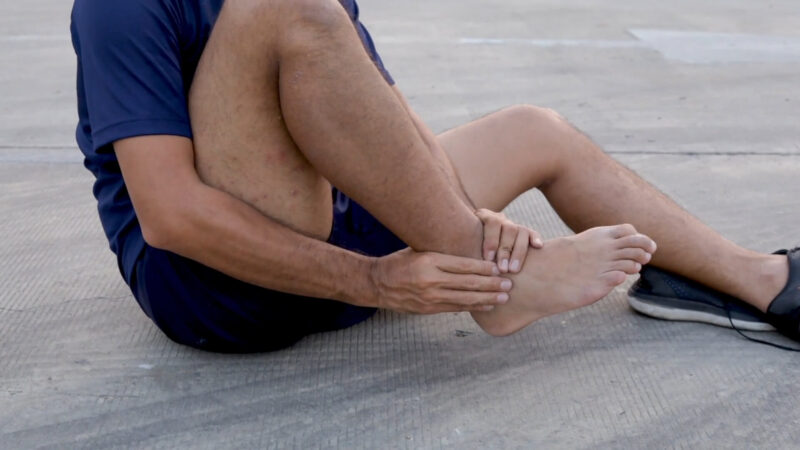
- Incorporate foods rich in omega-3 fatty acids, antioxidants, and vitamins to help reduce inflammation. A diet high in fruits, vegetables, lean proteins, and whole grains can support the body’s natural healing processes and mitigate inflammation in the plantar fascia.
- Drinking plenty of water supports overall health and can aid in the healing process. Proper hydration helps maintain the elasticity and health of the plantar fascia and other connective tissues in the body, reducing the risk of tears and inflammation.
- Techniques such as meditation, yoga, and deep-breathing exercises can help manage stress, which may indirectly impact recovery. Stress can increase the body’s sensitivity to pain and inflammation, so managing stress levels can improve the overall effectiveness of treatment strategies for plantar fasciitis.
When to See a Professional?
If your heel pain does not improve with home treatment, it may be time to see a healthcare provider. Continued discomfort may indicate a more serious condition or the need for a tailored treatment plan, which only a professional can provide.
A physical therapist can design a tailored exercise program to strengthen your foot, improve flexibility, and reduce pain. Professional guidance ensures that exercises are done correctly and effectively, maximizing the benefits and minimizing the risk of further injury.
For severe cases, treatments may include corticosteroid injections, shock wave therapy, or surgery as a last resort.
These interventions are considered when conservative measures fail to provide relief, and they aim to reduce inflammation, promote healing, or correct structural issues contributing to the pain.
FAQs
Can plantar fasciitis lead to more serious conditions if left untreated?
Yes, if left untreated, plantar fasciitis can lead to chronic heel pain that hinders your regular activities. It can also cause changes in your walking patterns, leading to foot, knee, hip, or back problems.
Are there specific types of shoes I should avoid to prevent aggravating plantar fasciitis?
Yes, it’s best to avoid high heels and shoes with inadequate support, such as flip-flops or old, worn-out athletic shoes. These types can increase the stress on your plantar fascia.
Is it beneficial to rest completely if I have plantar fasciitis, or should I continue some form of exercise?
While rest is important, complete inactivity can lead to stiffness and increased pain. Engaging in low-impact exercises, like swimming or cycling, can help maintain fitness without putting too much strain on your feet.
How long does it typically take to recover from plantar fasciitis with home treatment?
Recovery time varies depending on the severity of the condition and how consistently one follows home treatment strategies. It can take several months to a year for symptoms to completely resolve.
Can weight loss have a significant impact on reducing the symptoms of plantar fasciitis?
Yes, weight loss can significantly reduce the stress on the plantar fascia, thereby alleviating symptoms. Maintaining a healthy weight helps minimize the pressure exerted on your feet with every step.
Are there any specific dietary supplements known to help with plantar fasciitis?
While no specific dietary supplement can cure plantar fasciitis, supplements rich in omega-3 fatty acids, magnesium, and turmeric may help reduce inflammation and support overall foot health.
Always consult a healthcare provider before starting any new supplement.
Summary
Morning heel pain doesn’t have to be a given in your daily routine. With the strategies outlined above, you can take control of your symptoms and enjoy pain-free mornings. Consistency is key to seeing improvements.
If your pain persists despite home treatment, consult a healthcare professional for a tailored approach.
